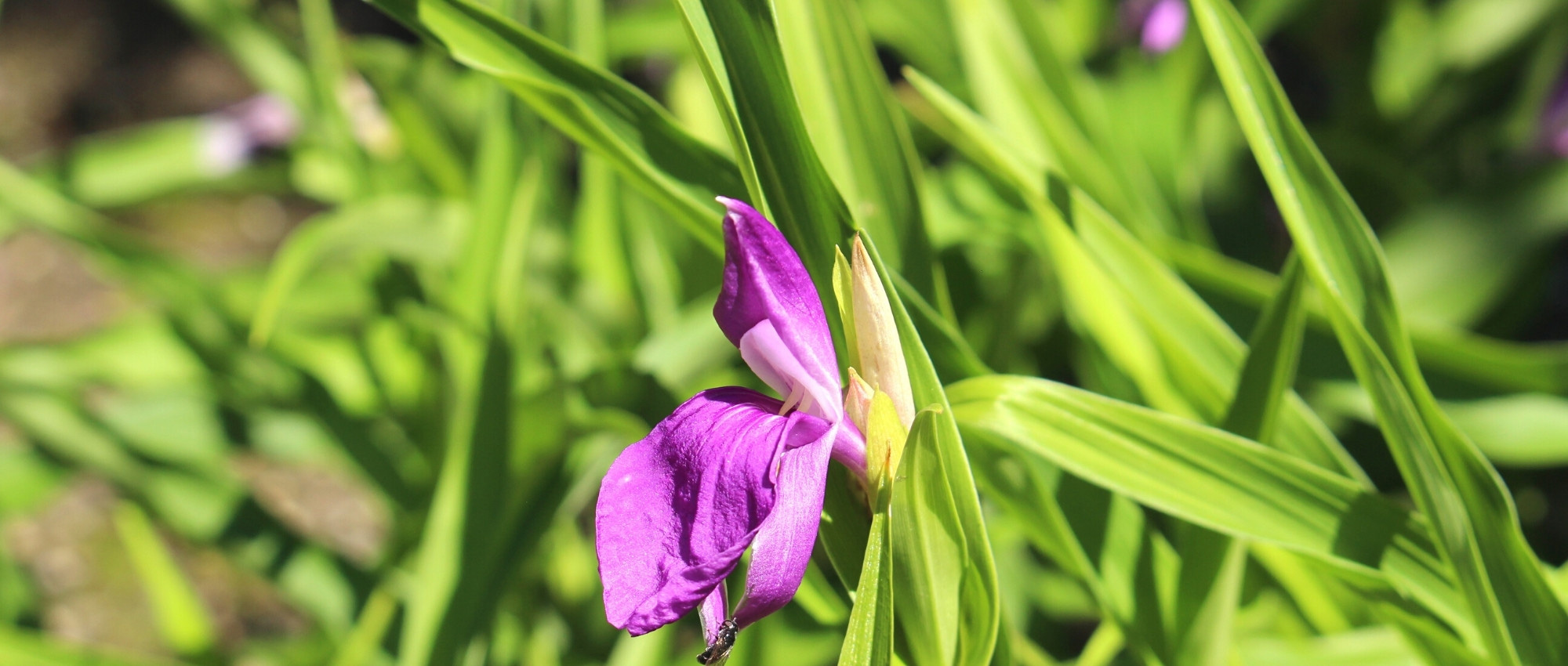
Roscoea: Planting, Growing and Caring
Contents
The Roscoea in a few words
- The Roscoea is a stunning perennial with orchid-like flowers, native to East Asia
- In summer, it produces refined flowers in shades of mauve, white, yellow, or red
- This plant thrives in partial shade, preferring cool, rich, and well-drained soil
- It fits effortlessly into naturalistic gardens, shaded rockeries, or Asian-inspired gardens
- It is quite hardy, tolerating temperatures as low as -15 to -20°C
The word from our expert
Roscoea is a tuberous plant from the ginger family, native to the mountainous regions of China and Nepal. It is prized for its delicate flowers that resemble orchids (earning it the nickname “ginger orchid”)! In summer, it produces flowers that are typically mauve violet or white, though some varieties may even be red or yellow. Its lush, well-defined foliage, with an exotic style, is also admired, sometimes adorned with purple or reddish foliar sheaths depending on the variety!
Roscoea is still a relatively unknown plant, rarely seen in gardens. Yet it has the advantage of being quite hardy, capable of withstanding temperatures between -15 and -20°C. It thrives in partial shade, protected from scorching sun, and prefers rich, moist, well-drained soil. Perfect for rock gardens, it also fits beautifully into exotic gardens, zen gardens, or naturalistic borders, and is ideal for enhancing patios, courtyards, or shaded terraces. Discover in this guide all our tips for growing Roscoea, whether in the ground or in pots!
botany
Botanical data
- Latin name Roscoea sp.
- Family Zingiberaceae
- Common name Orchid ginger, False orchid
- Flowering summer, between June and September
- Height generally between 20 and 50 cm
- Sun exposure partial shade, non-scorching sun
- Soil type fresh, rich, well-drained
- Hardiness between – 15 and – 20 °C
Roscoeas comprise 22 species of tuberous herbaceous perennials native to East Asia, primarily China, Nepal, and India. They grow in scree, meadows, and forest edges, at altitudes between 1,200 and 5,000 metres in mountainous regions, particularly the Himalayas. This explains their good hardiness, as Roscoeas can withstand temperatures as low as – 15 to – 20 °C.
Being deciduous, Roscoeas spend the winter underground as tubers and emerge late in spring, which helps protect them from the cold! In regions with harsh climates, this protection can be enhanced by placing a thick mulch over the stump, providing additional thermal insulation.
Roscoea belongs to the ginger family, the Zingiberaceae. Most plants in this family are tropical, but Roscoea comes from cool, mountainous regions, showing considerable hardiness. This family includes many plants used as spices: turmeric, ginger, cardamom, galangal… as well as ornamental plants like hedychiums and alpinias.
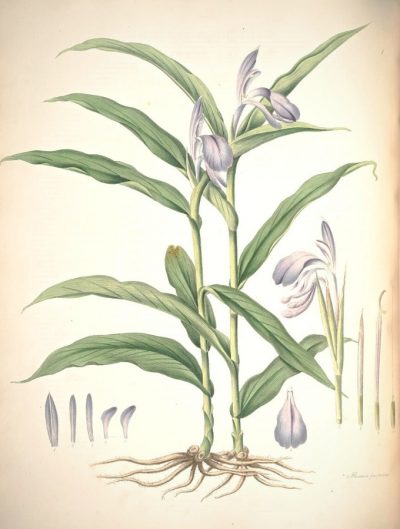
Roscoea purpurea: Botanical illustration
The Roscoea was named by the English botanist James Edward Smith in 1806, in honour of his friend William Roscoe, the founder of the Liverpool botanical garden. Roscoe was known for his interest in Zingiberaceae and had a fine collection himself. The species name purpurea alludes to the colour of the flowers.
Roscoeas are not very large plants: they typically measure 30 to 40 cm in height. However, the smallest species, such as Roscoea humeana, do not exceed 20 cm in height, while the tallest, like Roscoea cautleyoides, reach about 60 cm. In the garden, Roscoeas are best placed at the front of borders.
Roscoea forms tuberous roots, resembling those of Dahlias. These allow the plant to store minerals and water, enabling it to overwinter in dormancy underground and thus protect itself from the cold.
Roscoea flowers in summer, between June and September, depending on the variety. The flowers appear above the foliage, at the top of their pseudostems (formed by the rolled bases of the leaves). Their flowers have a complex structure and closely resemble orchid flowers. They measure about 5 cm in diameter and have soft, luminous hues: most commonly mauve-violet or white, but they can also be pale yellow (Roscoea cautleyoides) or bright red (Roscoea ‘Red Gurkha’). Their delicate, airy style makes them easy to incorporate into naturalistic partial-shade gardens! The decorative parts of the flowers consist of three petals (with an upper petal shaped like a galea and two finer petals) and four sterile stamens (staminodes), which resemble petals: two are positioned above, and the other two are fused into a central lower lip. The flower also has one fertile stamen, which carries the pollen.

Roscoea flowers come in beautiful shades depending on the variety! Roscoea purpurea, Roscoea ‘Red Gurkha’, Roscoea ‘Spice Island’ (photo Teresa Grau Ros), and Roscoea cautleyoides
The flower extends into a long floral tube containing nectar. When insects land on the flower to consume the nectar, they touch the fertile stamen, which automatically deposits pollen on their backs. They then carry this to the pistil of another flower, enabling its fertilisation and the development of seeds.
Roscoeas are deciduous: their leaves dry out in autumn and regrow in spring. They start late in spring: the first stems and leaves only appear around June. This allows the plant to protect itself from late frosts. It then grows rapidly, sometimes producing flowers as early as June or July.
The leaves of Roscoea are lanceolate, long, and slender, arched. They generally measure between 15 and 25 cm in length and are sheathing at the base (the lamina surrounds the stem). The foliar sheaths can be green or coloured: sometimes purple, brown, or red, depending on the species. The Roscoea ‘Spice Island’, for example, has brown foliar sheaths and dark leaves with a reddish underside, which beautifully highlights the flowering!
After flowering, Roscoea forms capsules containing the seeds. These have arils, small fleshy outgrowths consumed by insects, particularly ants. Attracted by the arils they eat, the ants carry the seeds with them, helping the plant to disperse.

The foliage of Roscoea purpurea ‘Red Gurkha’, Roscoea auriculata ‘Floriade’ (photos: Leonora Enking), and Roscoea ‘Cinnamon Stick’, with its reddish foliar sheaths
Read also
10 plants to create a shady rockeryThe main varieties of Roscoea
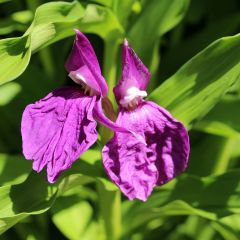
Roscoea purpurea
- Flowering time August to October
- Height at maturity 40 cm
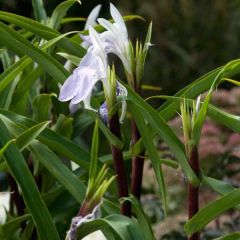
Roscoea purpurea Cinnamon Stick
- Flowering time September, October
- Height at maturity 50 cm
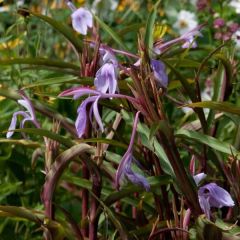
Roscoea purpurea Spice Island
- Flowering time September, October
- Height at maturity 60 cm
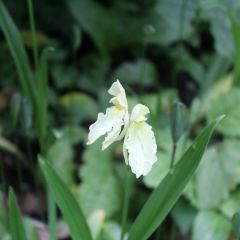
Roscoea cautleyoides
- Flowering time August to October
- Height at maturity 30 cm
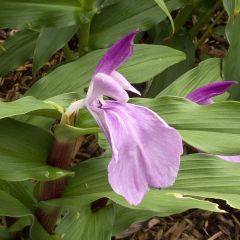
Roscoea purpurea Dalai Lama
- Flowering time August to October
- Height at maturity 40 cm
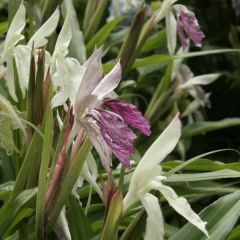
Roscoea beesiana
- Flowering time August, September
- Height at maturity 40 cm
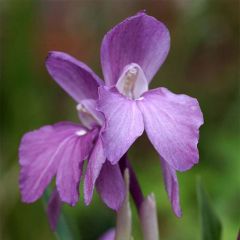
Roscoea humeana
- Flowering time June to August
- Height at maturity 25 cm
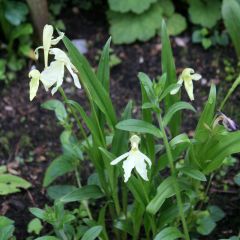
Roscoea beesiana Alba
- Flowering time July to September
- Height at maturity 40 cm
Discover other Roscoea
View all →Available in 0 sizes
Available in 2 sizes
Available in 1 sizes
Available in 1 sizes
Available in 1 sizes
Available in 1 sizes
Available in 1 sizes
Available in 1 sizes
Available in 1 sizes
Planting Roscoea
Where to Plant?
Plant the Roscoea preferably in partial shade, or in non-scorching sun if you live in the northern half of France. It needs shade during the hottest hours but still enjoys bright conditions. Under dense and thick shade, the Roscoea might develop a more flexible habit and less pronounced colours. If possible, choose a location sheltered from cold winds.
The Roscoea thrives in rich, humus-bearing soil: don’t hesitate to add well-decomposed compost at planting time. It also prefers soil that remains cool in summer but is well-drained. Regarding pH, the Roscoea has a preference for acidic soil but will also grow in neutral soil. You can add a bit of heather soil when planting.
As it enjoys well-drained, even stony soil and is naturally found in scree zones, the Roscoea will thrive in a cool rockery in shade or partial shade. With its delicate orchid-like flowering, it is also perfect for shaded naturalistic gardens and Asian-style gardens. It adapts equally well to pot planting and can enhance a terrace, small garden, or balcony facing north or east.
When to Plant?
The best time to plant the Roscoea is in spring, around May, once the risk of frost has passed.
How to Plant?
In the ground:
- Once you’ve chosen the location, dig a planting hole, at least 20-30 cm deep. Feel free to dig a wide hole to plant several young plants together.
- Mix well-decomposed compost and coarse sand into the planting soil to enrich the soil and promote good drainage.
- Plant the Roscoea tubercles 10 to 15 cm deep.
- Cover with soil and lightly firm.
- Water generously.
In a pot:
- Choose a pot at least 30 cm deep. Ensure it has drainage holes at the bottom to allow excess water to escape.
- Add a drainage layer made of clay pebbles or gravel.
- Then add a mixture of potting compost, garden soil, and coarse sand.
- Plant the tubercles so they are buried under 10 to 15 cm of substrate.
- Cover them with compost.
- Water.
- Place the pot in partial shade.
→ Learn more about growing Roscoea in pots in our advice sheet!
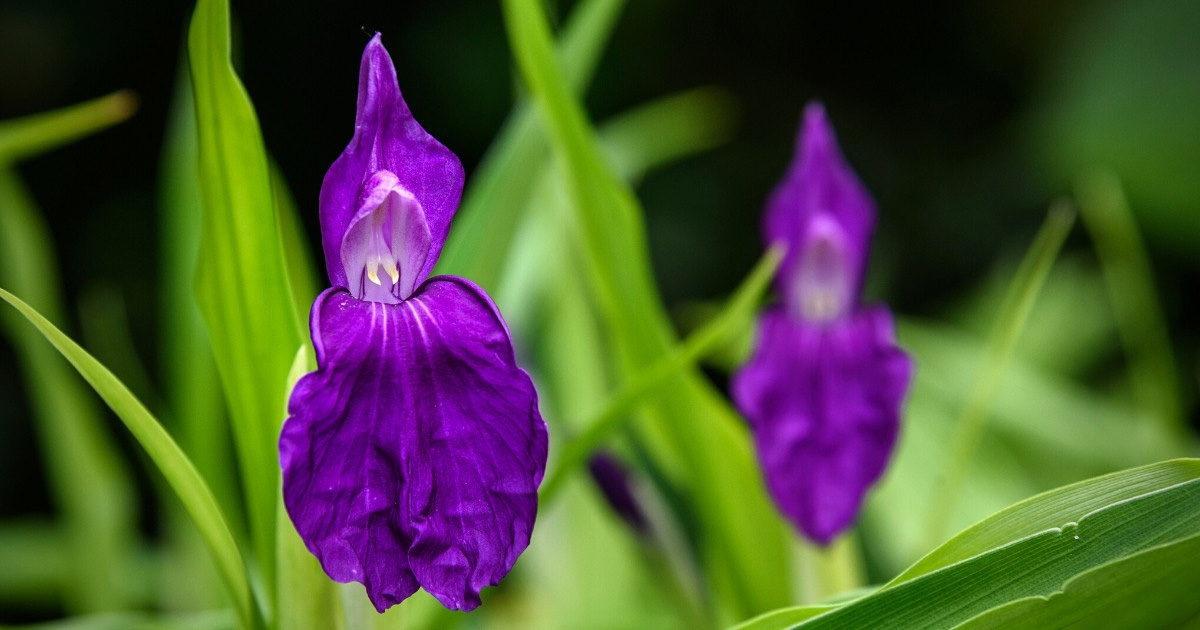
Roscoea purpurea
Maintenance
Native to monsoon regions, Roscoeas require moisture in summer and relatively dry conditions in winter. Ideally, the soil should remain cool in spring and summer: remember to water it regularly when rainfall is insufficient. Once the Roscoea has flowered, you can reduce watering and then stop it completely as soon as the plant enters dormancy. Feel free to add a layer of mulch around its base to retain soil moisture for longer.
In most French regions, Roscoea can remain in the ground during winter, as it can withstand temperatures as low as –15 to –20 °C. However, if you live in an area with particularly harsh winters (montane or semi-continental climate), you can protect the Roscoea from the cold by covering the stump in autumn with a thick layer of mulch made from dead leaves or bark. If grown in pots, it’s easy to move it into an unheated greenhouse or any frost-free shelter. Similarly, planting the tubercles deep (about 15 cm underground) helps protect the Roscoea from the cold.
Don’t hesitate to add some well-rotted compost around the base of the Roscoea in spring to enrich the soil and encourage flowering.
You can remove faded flowers as you see them, both for aesthetic reasons and to encourage the plant to produce new flowers.
Watch out for snails and slugs in spring, as they enjoy nibbling on young leaves and shoots. You can protect your young plants with slug repellent or create a slug trap. For more information and advice, check out our guide “Slugs: 7 Effective and Natural Ways to Control Them”. Vine weevils can also attack Roscoeas.
Multiplication
Roscoeas can be propagated by sowing fresh seeds or by dividing clumps. Division is quicker and easier to succeed than sowing.
Sowing
Sowing Roscoea is done in late summer, in August or September, using fresh seeds (harvested shortly before).
- Prepare pots with a fine, well-draining substrate, ideally a special sowing compost, then lightly tamp down and level the surface.
- Sow the seeds by scattering them on the surface.
- Cover them with a very thin layer of compost.
- Water gently, using a fine spray.
- Place the pots in a cold frame, in a bright spot without direct sunlight, and ensure the substrate remains slightly moist until germination.
Once the seedlings reach a size that allows handling, you can repot them into individual pots. Patience is then required: Roscoeas grown from seed generally take 3 to 4 years before they start to flower.
Dividing Clumps
Division is the ideal technique if you have large, well-established Roscoea plants. It is carried out in spring. You can divide your Roscoeas every 3 to 4 years.
- Choose a large clump of Roscoea, then dig it up carefully, making sure to dig wide enough to avoid damaging the roots.
- Remove any excess soil if necessary, then divide the clump into several sections, ensuring each has roots attached.
- Replant, either in the ground or in pots, burying the tubercles about 15 cm deep.
- Water generously.
Association
With its lush foliage and unique flowering, the Roscoea easily finds its place in an exotic-style garden. Pair it with colourful foliage in warm tones, such as that of the Phormium ‘Pink Panther’, the Colocasia ‘Black Magic’, the Canna ‘Durban’, or the Cordyline ‘Southern Splendour’. Opt for plants with striking, large leaves: incorporate banana plants, palms, Tetrapanax, Gunnera, Fatsia… Their lush vegetation will create a true jungle atmosphere! For flowering companions, consider crocosmias, kniphofias, Belamcanda chinensis, cannas… Alongside them, plant an Hedychium gardnerianum to enjoy its highly original flowering!
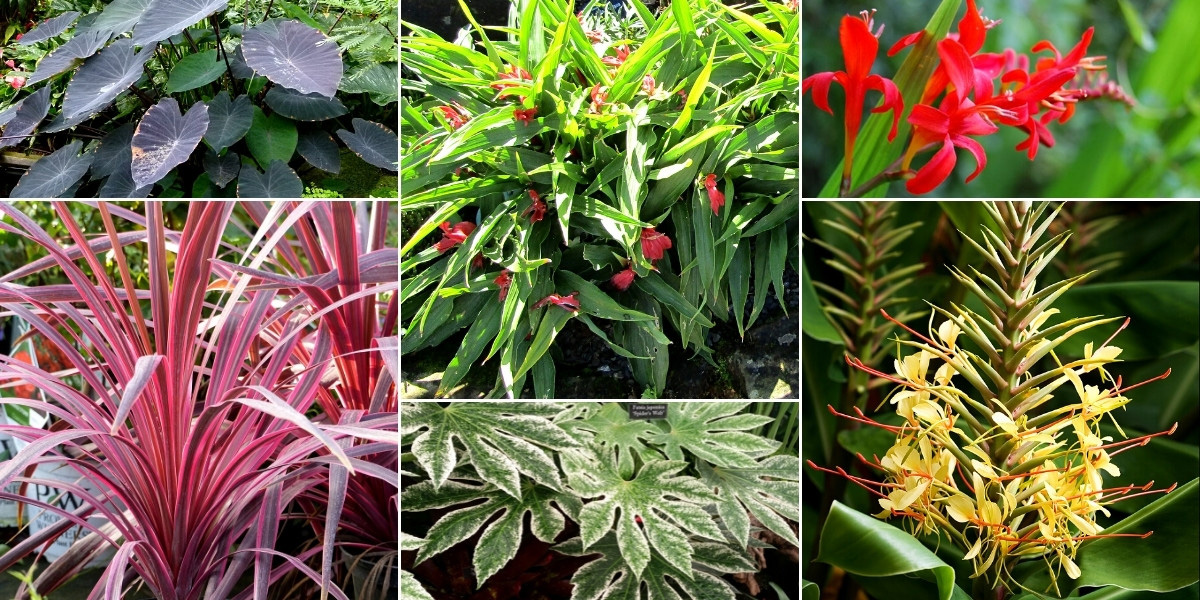
Exotic atmosphere with Colocasia ‘Black Magic’ (photo J. Rebel), Roscoea purpurea ‘Red Gurkha’ (photo Leonora Enking), Crocosmia ‘Lucifer’ (photo Vicky Brock), Cordyline australis ‘Southern Splendour’, and Hedychium gardnerianum (photo J.J. Harrison)
The orchid-like flowers of the Roscoea are also perfect for naturalistic-style gardens. Their light and delicate style fits in beautifully here! To accompany them, consider the airy blooms of willowherbs, masterworts, stem-clasping persicarias, astilbes, Veronicastrums, and Japanese anemones. You can also include garden orchids: discover, for example, the stunning Calanthe triplicata, which offers small, highly refined flowers with pure white petals!
Roscoeas can easily fit into a cool, shaded rockery, alongside saxifrages, dead-nettles, corydalis, and foamflowers. Also consider ferns such as the Asian species Coniogramme emeiensis, with its highly graphic fronds, and the Hart’s Tongue Fern, which forms clumps of beautiful, long, upright, evergreen green fronds.
Native to East Asia, Roscoeas will find their place in a zen garden, in an Asian style, alongside Japanese maples, Hakonechloa macra, hostas, and bamboos. This will allow you to create a very soothing atmosphere, perfect for meditation!

A naturalistic garden with Epilobium angustifolium, Roscoea cautleoides (photo Andy king50), Geranium riversleaianum ‘Mavis Simpson’, Persicaria amplexicaulis ‘Firetail’, Astrantia major ‘Ruby Star’, and Calanthe triplicata (photo Kuo-Chu Yueh)
→ Discover more ideas for pairing Roscoea in our advice sheet!
- Subscribe!
- Contents































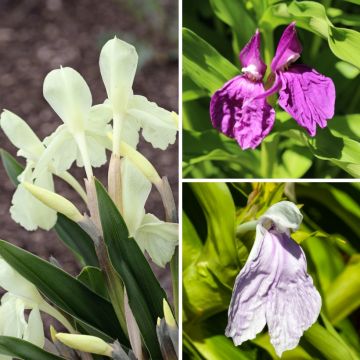








Comments